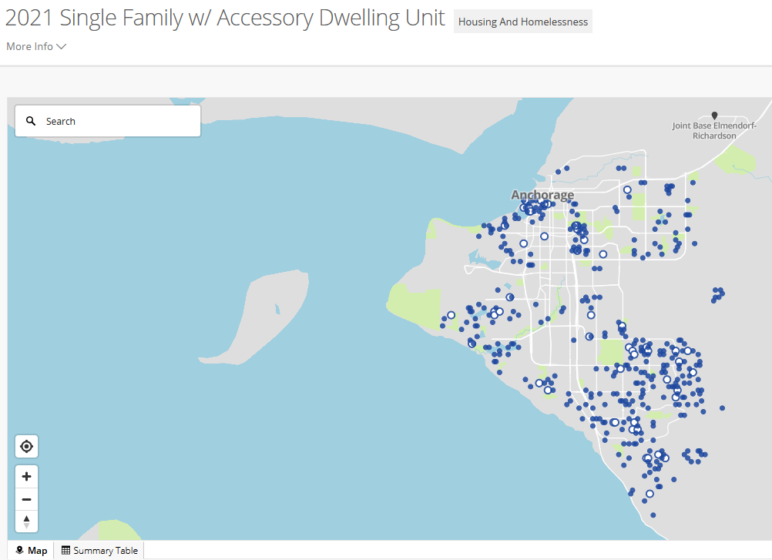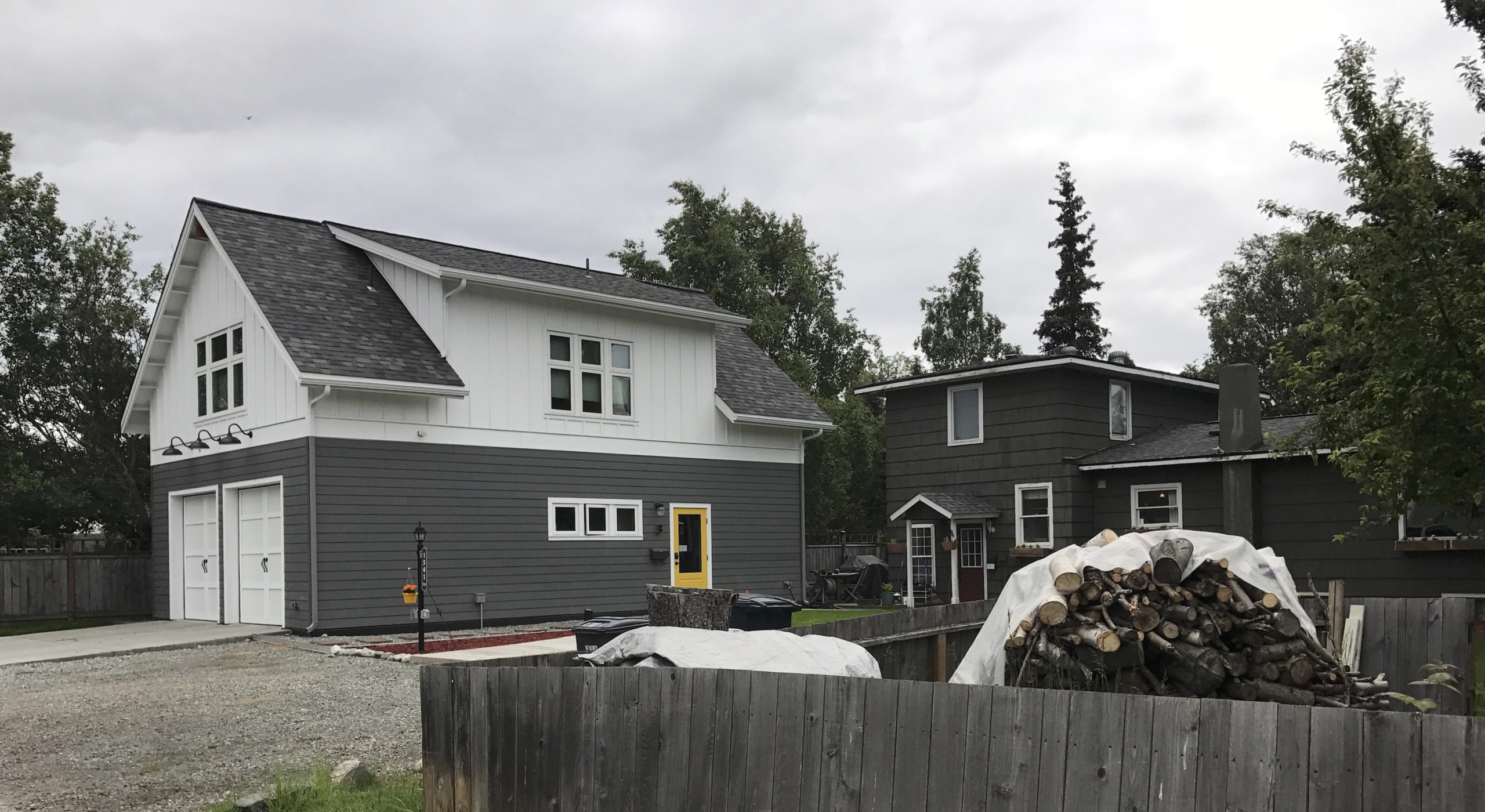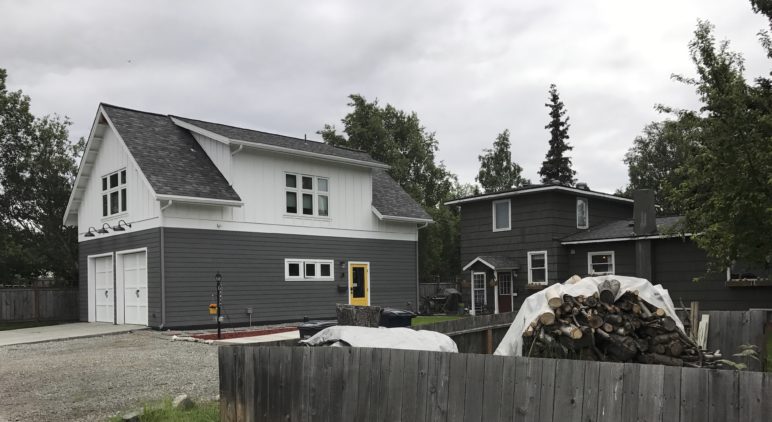In Anchorage, there are lots of rules about what you can do with buildings on your private property. Most make sense, like mandating earthquake-resistant structures and preventing properties from becoming junkyards. But the city’s zoning code still contains regulations that can do more harm than good by deterring homebuilding and limiting housing choices.
Take regulations that impose limits on building an accessory dwelling unit (ADU), also known as a garden cottage, granny flat, or secondary suite. ADUs are relatively modest, but complete, living spaces paired with a house on the same lot. They fall into two broad categories: attached and detached. Attached ADUs (AADU) are part of the main house. Detached ADUs (DADU) are a separate living unit, like a small cabin in the backyard or a studio over a detached garage.
Both attached and detached ADUs are often indistinguishable from the primary home. They provide flexibility and choice in typically monolithic detached house neighborhoods. They can accommodate everyone from seniors aging in place, to deeply traditional multigenerational families, to minimalist millennials and Gen Zers. ADUs offer the happy paradox of increasing property values while also helping to keep rents under control in desirable neighborhoods.
ADUs offer the happy paradox of increasing property values while also helping to keep rents under control in desirable neighborhoods.

Recognizing the many upsides of ADUs, the Anchorage Assembly revised the city’s ADU ordinance in 2018 to remove some of the obstacles faced by homeowners who’d like to build backyard dwellings, above-garage studios, and other types of ADUs on their properties. Still, only about two percent of the 52,913 single-detached homes in Anchorage have ADUs (and of the 106,567 occupied living units in Anchorage, less than one percent are ADUs), according to data from the city and the US Census. We’ll explain in more detail why Anchorage should add more ADUs to its housing menu and suggest ways the city might further deregulate zoning codes to allow more to be built.
The case for more ADUs
In explaining the benefits of the 2018 ADU ordinance, the Assembly pointed out that ADUs can help moderate population loss, make desirable neighborhoods more affordable, and confer financial benefits on property owners and renters. The Assembly also recognized Anchorage needed more options for residential expansion in the Anchorage bowl, which is hemmed in by the Chugach mountains and Cook Inlet. In addition, because they are smaller, ADUs are less expensive to heat than traditional detached houses, offering cost savings on energy during the colder months.
Keeping more Alaskans in Alaska
Anchorage’s population has shrunk slightly each year for the past six years, from a historic high of 301,000 in 2013 to the most recent estimate of 291,845 in 2019. With lower oil prices weakening the state economy and better job prospects in the booming pre-pandemic economy of the lower 48, Alaska has been facing headwinds in attracting new residents. The population decline is happening on a statewide basis, with the exception of the Matanuska-Susitna Borough, north of Anchorage. Keeping Anchorage’s population at a healthy level, by attracting new residents and keeping existing ones, will require purposeful policy changes to make the city a place where people want to settle down.
Offering more reasonably priced housing options in desirable neighborhoods is one way to help stabilize Anchorage’s population. Seniors, aged 60 and up, make up about 16 percent of the population. As consumers, they are a key part of the Anchorage economy. They also play important roles as volunteers for nonprofits. And their vast collective knowledge of Anchorage’s land, society, politics, and institutions helps drive informed civic conversation.
In 2020, more than 2,600 seniors moved out of Anchorage, the highest number to leave in the last five years. One way to keep seniors in Anchorage longer is to build housing that works for them. More ADUs mean more Anchorage seniors will be able to age in place in housing whose cost accommodates a fixed income. They might decide to remain in their neighborhood, downsizing to their backyard cottage and renting out the principal dwelling. Or they might bring family members into the main house and delay (or never make) the move into the Pioneer Homes or other assisted living facility.
The senior-friendly nature of ADUs has attracted strong support from AARP, the country’s most powerful lobbying group for seniors.

The affordability of ADUs can also attract people on starting salaries who prioritize location over square footage. The pandemic and subsequent rise in remote work has brought many young Alaskans back home, for now at least, and created an opportunity to recruit workers away from major cities in the lower 48. The Anchorage Economic Development Corporation has started a campaign to attract mobile employees to the city. Good housing in walkable neighborhoods with easy access to restaurants, trails, and other amenities will be critical to AEDC’s success in bringing younger adults to Alaska and convincing them to stay. ADUs can be a part of this solution.
Increasing access to desirable neighborhoods
The desire to preserve neighborhood character is often a reason owners of detached single homes resist the addition of more reasonably priced housing in their neighborhoods. ADUs offer a happy medium, allowing for relatively attainable new housing while not changing the overall look and feel of neighborhoods. Allowing more ADUs in Anchorage’s detached single house zones can improve equitable access to neighborhoods within walking distance to trails and stronger-performing schools.
As a more price-accessible housing option, ADUs increase opportunities for people in a wider range of income brackets to live side-by-side. For example, ADUs make it possible for students and young families to afford desirable zip codes near work, school, and Anchorage’s trail system. The predominantly liberal neighborhoods near downtown and midtown that have resisted ADUs in the past may want to reexamine their potential for helping Anchorage become a more diverse and equitable city.
ADUs help the finances of both homeowners and renters
From a financial standpoint, ADUs offer benefits for both property owners and ADU inhabitants. ADUs can easily cost tens of thousands of dollars to build. However, because ADUs are still relatively uncommon, assessors and banks have no established standards for estimating their value. In Anchorage, the municipal assessor’s office verified that the most significant driver of property value is the living area. Since ADUs add more square footage for people to live, they add value to the property, with the amount varying based on factors such as location and quality of building materials.
Of course, each homeowner needs to figure out whether the increase in property value and other upsides of having an ADU, financial or otherwise, balance out the cost of building, maintaining, and paying taxes on the unit. One option for recouping the cost, and possibly offsetting the cost of a mortgage, is to tap into Anchorage’s robust rental market. About 39 percent of occupied living units in Anchorage are rentals, housing about 100,000 renters, according to US Census data. Renting a two-bedroom apartment in Anchorage costs about $1,140 per month, according to the 2020 rental market report from the state Department of Labor and Workforce Development. A one-bedroom rental costs about $961 per month.
More ADUs could also be good for renters’ wallets. Though ADUs will likely remain a very small percentage of Anchorage’s rental market for quite some time, they can incrementally increase the choice of rental stock in a wider variety of neighborhoods and also stoke a little more competition for tenants among landlords, putting downward pressure on rents.
An overview of ADUs in the Anchorage bowl
The city estimates there are at least 1,000 attached and detached ADUs in the Anchorage bowl, not all of which have yet been officially logged by property appraisers. They appear in a variety of neighborhoods, from the suburban-wildland interface of Stuckagain Heights and the lower Hillside, where larger lots and zoning regulations have made construction easier than in other parts of the city, to clusters closer to downtown, in Inlet View, Midtown, and Rogers Park. ADUs are hard to accurately count in Anchorage. About 600 are on record in the municipal property appraisal database, but there are likely another 400 or so that have not been permitted, according to Chris Schutte, Anchorage’s director of economic and community development. Click on the Anchorage ADU map, below, for more detail.

A map of the Municipality of Anchorage shows about 600 ADUs throughout the city, from Chugiak to Girdwood. Filings of ADU owner occupancy affidavits indicate about two dozen have been added each year since the city updated its ADU ordinance in June 2018. (Map Credit: Municipality of Anchorage Innovation Team)
The Anchorage Assembly updated the ADU ordinance in June 2018 in an attempt to spur more ADU construction. The biggest change was to get rid of a ban on ADUs in the R-1 and R-1A zones, which previously only allowed construction of single-detached houses. The new ordinance also removed or rewrote other rules: Homeowners with lots smaller than 20,000 square feet can now build detached ADUs as long as they follow other zoning restrictions. The city also slightly loosened parking requirements. Design requirements are less prescriptive. The maximum gross floor area in urban districts is higher. And household size rose from a max of two people in the ADU to either any number of related people or no more than five unrelated people.
Comparison of Old and Current ADU Codes in Anchorage, Alaska
| Old Code (pre-2014) | Current Code (2018) | |
|---|---|---|
| ADU Types Allowed in Single Family Zones | ADUs are not allowed in R-1 and R-1A districts, which are zoned for single-family only. On single-family lots outside those districts AADUs attached to the home or to the garage are allowed. DADUs are only allowed on lots 20,000 sq ft or greater OR on lots abutting an alley AND must be part of the garage. | AADUs and DADUs are both allowed in all zones. DADUs no longer need to be attached to a garage. |
| Off-Street Parking Requirements | One off-street parking space per ADU required, in addition to the parking spaces required for the main house. | One parking space required per ADU, which the city traffic engineer may allow to be on-street. Owners may also sign a no-car covenant for the ADU to waive the parking requirement. |
| Maximum Gross Floor Area | ADU cannot be larger than 35 percent of gross floor area of the principal dwelling unit, but no less than 300 square feet. No more than two bedrooms. | Class A districts (urban): size may not exceed 900 sq. ft. or 75 percent of the total area of the primary home. Class B districts (rural): size may not exceed 900 sq. ft. or 35 percent of the total area of the primary home. No more than two bedrooms. |
| Minimum Lot Size Required to Build an ADU | Detached ADUs above/attached to a garage are allowed only if the parcel is 20,000+ sq. ft and the single-family dwelling is the only principal structure or the property abuts an alley and the DADU is above a detached garage abutting the alley and the single-family dwelling is the only principal structure | Must conform to lot coverage restrictions, setbacks, and dimensions for the underlying zoning district. |
| Lot Coverage | Lot coverage of the principal dwelling unit and all accessory structures combined, including, but not limited to the ADU, shall be less than or equal to the max lot coverage allowed by the zoning district. | No change. |
| Household Size | No more than two people may live in the ADU. | Any number of related people or no more than five unrelated people. |
| Exterior Design Requirements | Shall maintain the architectural style and character of the single-family residence, including exterior siding, roofing, exterior window trim, window proportions, patterns, and orientation. | Design requirements determined by lot coverage, building size, and entryway placement requirements in each zoning district. |
| Entry Location | An additional entry door on the side of a principal structure facing the street for entrance into an ADU is prohibited. Entrances are permitted on the non-street-facing sides of the principal structure. | For AADUs, the entry door isn't permitted on the same side as the primary dwelling, but may be located on non-street-facing sides. DADUs are exempt. |
| Maximum Height | Max height is 25 feet for a detached ADU. | No change. |
| Setbacks | ADU shall not encroach into any required setback, except where the rear yard abuts an alley. | ADU shall not encroach into any required setback, except into the side or rear setback abutting an alley. DADUs taller than 15 feet must have a 10-foot side setback abutting a neighboring R-1 or R-1A lot. |
| Owner Occupancy Requirements | Required. Principal dwelling or ADU must be primary residence (for more than six months per year). | No change. |
The best data on ADU activity since the ordinance passed comes from the tally of affidavits property owners must file if they intend to build an ADU. The affidavits state that the owner will be a resident on the property where the ADU is located, either in the principal dwelling or in the ADU itself. Affidavits rose slightly after the ordinance passed. From 2013-2017, an average of 17 affidavits were filed each year with the city. Since the ordinance passed, an average of two dozen have been filed per year.
While the numbers suggest a modest improvement following passage of the ordinance, the available data can’t confirm a causal relationship. (Knowing how many detached ADUs have been permitted on lots smaller than 20,000 square feet since 2018 would give us a better picture since those types of ADUs were not previously allowed; however, the permitting records are not set up to easily yield that information.)
Still, the ordinance did loosen some restrictions and brought increased awareness of how ADU construction can help more people access reasonably-priced housing. And its passage may open the way to more regulatory changes that make it easier for homeowners and developers to add ADUs.
How can Anchorage support ADUs?
Following an independent review of Anchorage’s code and conversations with city planners and housing policy experts, Sightline identified the following policy changes officials and the public might consider to make it even easier to add ADUs into Anchorage’s housing mix.
1. Remove the owner occupancy requirement
Anchorage currently requires that the owner live on-site when an ADU is on the property. No rules like this exist for any other housing type in Anchorage. For instance, single-family homes may be rented out, even if the owners live halfway around the world.
Owner occupancy rules discriminate against renters and are often based on the stereotype that renters are less likely than owners to be good neighbors.

As Sightline has written in the past, the owner occupancy rule “gives bankers the jitters.” Owner occupancy sharply limits the value appraisers can assign to a house and ADU, according to the national office of AARP, and makes the property less valuable as loan collateral. If a bank forecloses on a house and suite covered by an owner-occupancy rule, it cannot rent out both units. In effect, owner occupancy may prevent many homeowners from securing loans to pay for an ADU. In addition, owner occupancy prevents any house that’s a rental from adding an ADU.
Removing this requirement would allow both owners and renters the flexibility of deciding where to live and make the financing of ADUs easier.
2. Jettison ADU parking requirements
The 2018 ordinance still requires an additional off-street parking space for an ADU, but offers two ways to avoid having to put in a new spot for a car. If the ADU’s inhabitants do not require vehicle parking, the owners can sign a no-car covenant. In cases where parking is already available on the lot or the street, the city traffic engineer may waive the requirement.
Anchorage can go a step further by removing the parking requirement entirely. Owners can then use their discretion to decide whether to spend a few thousand dollars or more to add off-street parking along with the ADU. Even without a requirement, there will still be plenty of parking for ADUs in Anchorage’s residential neighborhoods. Only one parking waiver has been requested since 2018, indicating that most homeowners and developers will likely opt to add on-site parking even without a mandate since vehicle ownership is so widespread in Anchorage, according to city officials. An environmental impact statement on ADUs for Seattle found that removing on-site parking mandates would not cause any adverse impacts on the availability of street parking. Given that Anchorage has far less neighborhood density and street traffic than Seattle, the effect of lifting parking requirements would likely be negligible.
For those with good reason for opting out, the parking waiver process still creates an additional bureaucratic hoop to jump through that can dissuade owners from taking on an ADU project. Having to build a parking spot to pair with an ADU is a costly imposition that at best complicates architectural plans and at worst makes projects unfeasible. A parking pad can kill an ADU project by either being physically impossible to squeeze onto a lot or driving costs beyond what the property owner is willing to pay. As AARP writes in its “Practical Solutions for ADUs,” parking requirements can often be “well-intentioned, but burdensome.”
3. Help homeowners finance ADUs
Removing excessive rules for ADUs will make them easier to build, but won’t reduce the up-front construction costs that often make ADUs inaccessible to homeowners, especially those with low incomes who could benefit from renting out an additional unit.
In recent years, some cities and counties across the country have explored programs to help homeowners finance ADU projects, often in exchange for keeping the additional unit at below-market rent. In 2017, Juneau piloted an accessory apartment grant program, which offered residents $6,000 toward building an ADU and helped finance the construction of 12 ADUs. ADUs created by remodeling existing structures cost about $32,000 on average, while ADUs in newly built structures cost about $79,000. The grant covered about 11 percent of average ADU costs.
4. Educate homeowners on financing, permitting, and building ADUs
Building an ADU can be a daunting task for a homeowner with no experience navigating complicated permitting, financing, and construction processes. Cities can provide educational resources for homeowners, such as centralized ADU information pages, community events explaining financial and other factors to consider, and guided workshops on the city’s ADU approval process. To speed up the construction and permitting process, some jurisdictions (such as Seattle, Lacey, San Jose, and San Diego County) offer pre-approved architectural plans for homeowners and contractors to follow. AARP also has a free ADU design catalogue drawing on architectural plans from major cities across the country.
5. Educate the public on the minor modification process
Anyone thinking about building an ADU should know that there is a process for addressing negligible non-conformances with code. The city has a mechanism (Title 21.03.120) for allowing minor encroachments into required development setbacks. For example, if the ADU encroachment is 5 percent or less of the setback distance, the Planning Director may approve a minor modification for the setback requirement. The process allows for small modifications that don’t pose a health or safety threat to the neighborhood.
6. Allow duplexes to coexist with ADUs
Anchorage can consider allowing ADUs on lots with duplexes. This could open up about 7,000 duplex homes across the city to ADUs. Other cities and states have either begun to allow them or are considering it. In 2018, Vancouver allowed one ADU for each duplex unit. In 2019, California allowed two DADUs on lots with duplexes, triplexes, fourplexes, and townhomes as well as a number of AADUs equal to 25 percent of the units. Seattle allows one ADU per dwelling in its zones for small-scale multifamily dwellings. A proposed ADU bill in the Washington State Legislature could open up duplexes to ADUs statewide.
ADU reform growing in popularity
Policy has a huge influence on ADU construction. Recognizing their advantages, cities including Portland, Oregon and Seattle have loosened regulation of ADUs and seen corresponding increases in their building. As an example of the potential, in Vancouver, BC over one-third of single-family properties have legal ADUs, or roughly 10 percent of the city’s total current housing stock. You can chalk up the difference to Vancouver’s elimination of counterproductive restrictions to ADUs, plus a strong real estate market. In recent years, AARP supported a suite of statewide ADU reforms in California, which caused permits to spike from 6,000 in 2018 to 16,000 in 2019. Washington State’s Legislature is now considering two bills that would incentivize ADU construction statewide.
Next steps for ADU reform in Anchorage
Loosening regulations on ADUs will not dramatically change the face of Anchorage’s housing market any time soon. Even if Anchorage were to double the number of ADUs, they would still make up only one to two percent of the total housing stock. ADUs are just one effective, low-impact strategy for gradually increasing the stock of reasonably priced housing in Anchorage. As the Washington Post aptly put it in an article about their growing popularity, ADUs are “more of a small tool in the box than a full-scale solution to affordability problems.”
Anchorage’s 2018 ADU ordinance put forth some strong and necessary revisions to Anchorage’s building code. But keeping the city’s population and economy stable during a time when oil, the state’s major industry, is shrinking, will require additional housing policy innovation. Further ADU reform is a small but highly achievable step for staying competitive in a new era for Anchorage and for Alaska.












Mark
Thank you, Jeannette and Nisma! Your article is very informative. As a senior, I think you make a strong case in your “Keeping more Alaskans in Alaska” section.
I forwarded a link to your story to a few of my family members and friends who live in/near Anchorage.
Jeannette
Excellent! Thanks so much for circulating this!
Barbara Neil
We love the thought put into this and yes, senior housing in Alaska. We’d love to see more Alaska seniors staying closer to home and family. baxterseniorliving.com
Todd P.
One of the major safety problems with ADUs is maintaining fire separation from the primary living quarters. If they are not built to the same standards as duplexes there is a risk of smoke/fire spreading and causing loss of life/property to both households.